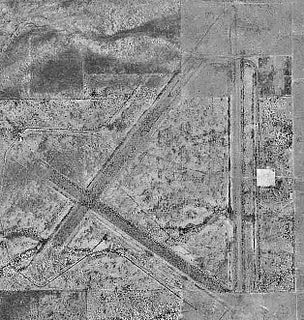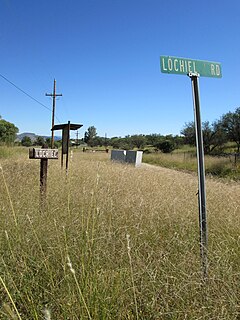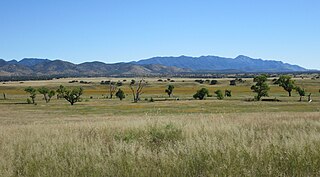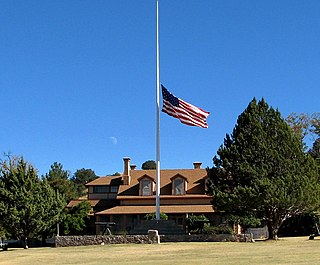
Casas Adobes is a census-designated place (CDP) located in the northern metropolitan area of Tucson, Arizona. The population was 66,795 at the 2010 census. Casas Adobes is situated south and southwest of the town of Oro Valley, and west of the community of Catalina Foothills.

One-room schools were commonplace throughout rural portions of various countries, including Prussia, Norway, Sweden, the United States, Canada, Australia, New Zealand, the United Kingdom, Ireland, and Spain. In most rural and small town schools, all of the students met in a single room. There, a single teacher taught academic basics to several grade levels of elementary-age boys and girls. While in many areas one-room schools are no longer used, it is not uncommon for them to remain in developing nations and rural or remote areas. Examples include remote parts of the American West, the Falklands, and the Shetland Islands.

The Santa Cruz River is a river in Southern Arizona and northern Sonora, Mexico. It is approximately 184 miles (296 km) long.

Arivaca is an unincorporated community in Pima County, Arizona. It is located 11 miles (18 km) north of the Mexican border and 35 miles (56 km) northwest of the port of entry at Nogales. The European-American history of the area dates back at least to 1695, although the community was not founded until 1878. Arivaca has the ZIP code 85601. The 85601 ZIP Code Tabulation Area had a population of 909 at the 2000 census.

Hereford is a populated place in Cochise County along the San Pedro Riparian National Conservation Area in the southern part of the U.S. state of Arizona. It is southeast of Sierra Vista and is a part of the Sierra Vista-Douglas micropolitan area. The elevation is 4,193 feet at the location of the original townsite at the far eastern end of the unincorporated area; the residential area runs for another 8 miles west from this location, blending into the unincorporated area of Nicksville at an elevation of approximately 4800'. Hereford Station Post Office is located at the far western end of Nicksville, at the foot of the Huachuca Mountains.
Henry O. Jaastad (1872–1965) was an influential Tucson, Arizona architect. His firm created over 500 buildings and Jaastad was Mayor of Tucson for 14 years. A number of his works are listed on the U.S. National Register of Historic Places for their architecture.

Canelo is a ghost town in eastern Santa Cruz County, Arizona, between the Canelo Hills and the northern end of the Huachuca Mountains. The site lies along Turkey Creek on Arizona State Route 83, between Sonoita and Parker Canyon Lake, which is about ten miles to the south-southeast in Cochise County. Today, several historic buildings listed on the National Register of Historic Places remain standing in Canelo, including a one-room schoolhouse and a United States Forest Service ranger station.

The Tucson Arizona Boys Chorus is a boys' choir based in Tucson, Arizona, which performs locally, nationally, and internationally. Founded in 1939 and incorporated as a non-profit educational organization in 1945, its mission is to facilitate music education and social development among Tucson youth ages 6 to 21. The chorus, presently numbering 150 members, sends out touring companies of 30 boys each who sing folk songs, Western ballads, Mexican songs, Christmas carols, spirituals, pop music, classical music, Broadway show tunes, and American patriotic songs. The boys also perform rope tricks. The chorus has performed in major venues around the world as well as on television and radio, and in collaboration with symphony orchestras and arts organizations. It has released albums both under its own label, TABC Records, and with Capitol Records, United Artists, and C.P. MacGregor.
The Jokake School for Girls was a ranch school in Scottsdale, Arizona. It operated from 1933 to 1945. It housed 40 students each year it was in existence. It was connected to the Jokake Inn, a guest ranch and winter hotel built by architect Robert Evans and backing out onto Camelback Mountain. The inn opened in 1927.

Aztec Land and Cattle Company, Limited ("Aztec") is a land company with a historic presence in Arizona. It was formed in 1884 and incorporated in early 1885 as a cattle ranching operation that purchased 1,000,000 acres in northern Arizona from the Atlantic & Pacific Railroad. It then imported approximately 32,000 head of cattle from Texas and commenced ranching operations in Arizona. Because Aztec's brand was the Hashknife, a saddler's knife used on early day ranches, the company was known more famously as The Hashknife Outfit. The company has been in continuous existence since 1884.

Lochiel is a populated place and former border crossing in southern Santa Cruz County, Arizona, approximately 25 miles east of Nogales. The townsite is located in the southwestern part of the San Rafael Valley on Washington Gulch about 1.5 miles west of the Santa Cruz River. It was first settled in the late-1870s and mostly abandoned by 1986. The town served the ranches of the San Rafael Valley and the Washington Camp and Duquesne mining towns of the Patagonia Mountains about five miles to the northwest up Washington Gulch.

Forest Grove School No. 5 is an historic building located near Bettendorf, Iowa, United States. It was listed on the National Register of Historic Places in 2013.

The Little Red Schoolhouse is a historic one-room schoolhouse located a few miles northeast of Nogales, Arizona, in the community of Beyerville. Opened in 1921 to serve the children of local farmers and ranchers, the Little Red Schoolhouse is the only one remaining of approximately two dozen red schoolhouses built in the Santa Cruz River valley in the 1920s.

The Canelo School is a historic one-room schoolhouse in eastern Santa Cruz County, Arizona, in the ghost town of Canelo. Opened in 1912, the Canelo School is one of the few one-room adobe schoolhouses remaining in the state. As a rare and well-preserved surviving example of a once common school building type in southern Arizona. The Canelo School was placed on the National Register of Historic Places on July 31, 1991.

The Arivaca Schoolhouse is a historic one-room school building located in the unincorporated community of Arivaca, in southern Pima County, Arizona. A small and simple structure made of locally manufactured mud adobe bricks, the Arivaca Schoolhouse was built in 1879 and is the oldest standing schoolhouse remaining in Arizona. It was added to the National Register of Historic Places on April 16, 2012, and is now used as a center for community activities.

Judith Davidson Chafee (1932–1998) was an American architect known for her work on residential buildings in Arizona and for being a professor of architecture at the University of Arizona. She was a recipient of the National Endowment of the Arts Fellowship to the American Academy in Rome during the middle of her career and was the first woman from Arizona to be named a Fellow of the American Institute of Architects.
San Luis Ranch School was a college preparatory ranch school for girls in Colorado Springs, Colorado established in 1889.

The Miracle Mile Historic District, located on North Stone Avenue, Drachman Street, Oracle Road and Miracle Mile in Tucson, Arizona, United States, was listed as a historic district on the National Register of Historic Places in 2017.




























